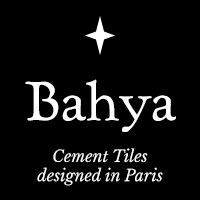




The characteristic of zellige is the variation in shade from one piece to another. These subtle variations are due to multiple factors (placement in the kiln, weather conditions, thickness). Zellige tiles are handcrafted piece by piece. It is a traditional craft, far from industrial standards.
Zellige, a glazed ceramic tile, is much more than just a decorative element. It is a traditional Moroccan tile made from Fez clay. A first firing gives it its rigidity, and it is then glazed on the surface.
It symbolizes Moroccan art and architecture, combining elegance and refinement. Originating in Morocco, this terracotta tile has a long history dating back centuries. It was once used to adorn palaces, mosques, and royal residences.
Moroccan artisans, skilled in ceramics, used to cut each piece by hand, creating mosaics with geometric and floral patterns that reflect the delicacy of Islamic art.
Over time, zellige has become a symbol of Moorish architecture. It is seen in famous monuments such as the Medersa Ben Youssef in Marrakech and the Great Mosque of Casablanca. Despite its historical roots, zellige has lost none of its appeal and easily adapts to contemporary tastes. It now finds its place in modern spaces like kitchens, bathrooms, or terraces, while retaining its traditional charm.
Zellige tiles now have their place in all interiors. In a kitchen, for example, they add a touch of warmth and can be used to create an elegant backsplash. The variations in color and natural shine create a unique atmosphere.
Zellige has the advantage of being easy to clean. A simple wipe with a sponge is enough, making it ideal for backsplashes, even behind a stove, or anywhere easy maintenance is a priority.
Zellige tiles are better suited as a wall covering rather than flooring, as their beveled edges can be sharp for bare feet in a bathroom.
A wall covered with black zellige can become a focal point in a living room or near a fireplace. This glazed terracotta resists heat well, creating a warm and inviting ambiance when used on walls.
In a bathroom, it shines and is waterproof, making it perfect for shower or bathtub walls. White zellige adds a pleasant brightness without the coldness of traditional tiles, offering variations far from the monotony of ceramic stoneware.
We advise against using zellige for flooring, especially in wet areas. For floors, it is recommended to choose cement tiles or bejmats, which are better suited.
Regarding glaze, all colors are possible... We offer around fifty colors. No matter which you choose, you'll find shade variations from one tile to another. This is the charm of zellige. No two tiles are identical.
If this variety of color is unique to Moroccan zellige tiles, so is the variety of shapes. The diversity of reflections, shades, and cuts highlights the walls on which our zellige tiles are placed.
All our zellige tiles and bejmats are handcrafted.
The different formats of zellige are obtained by cutting each piece after firing. The edges are then beveled with a sharp hammer, allowing the grout to ensure waterproofing even when the tiles are placed edge to edge.
We have complete freedom with formats and shapes. Square formats in 10x10 cm or 5x5 cm are the most common. If your project requires shapes or formats not listed below, do not hesitate to contact us.
The wide range of colors allows for the creation of diverse atmospheres.
Our range of grays, from dark to light, can warm up certain backsplashes. A powder pink will create a cozy atmosphere in a bathroom. Green zellige, a flagship choice, comes in a variety of unique shades.
Whether in shades of pink, sea green, or emerald, zellige allows you to shape a space.
Color combinations are stunning. For example, powder pink and sage green blend harmoniously together.
By choosing zellige, you embrace imperfection and authenticity. The irregular cuts and colors are part of its charm. This tile appeals to those seeking an artisanal aesthetic. Zellige is a solid alternative to the ubiquitous subway tile.
The bejmat, another Moroccan terracotta tile, offers an interesting alternative to zellige. It is not cut by hand but molded, giving it a more regular shape.
It can be glazed or left raw for a more natural look. The bejmat is suitable for floors, as it is more comfortable for bare feet, making it ideal for bathrooms.
Bejmat is also available in various formats, the most well-known being the 15x5 cm rectangle, perfect for herringbone patterns, though it can also be laid vertically or horizontally.
Bejmat is perfectly suited for both floors and walls. When choosing bathroom tiles, be sure to consider this tile for interior flooring.
Bejmat is also ideal for outdoor spaces, providing good grip. When unglazed, it must be treated to become waterproof and frost-resistant.
It fits well in a living room or dining area, evoking traditional country houses with its rustic look.
Glazed bejmat is moisture-resistant and can be used for both wall and floor tiles, making it perfect for shower walls.
Zellige and bejmat are authentic and unique decorative choices.
Zellige, with its natural imperfections, fits perfectly in both modern and traditional decor. However, it is best suited as a wall tile.
Bejmat, being more robust, is ideal for tile flooring and high-traffic areas, adding warmth and natural elegance to your spaces.

